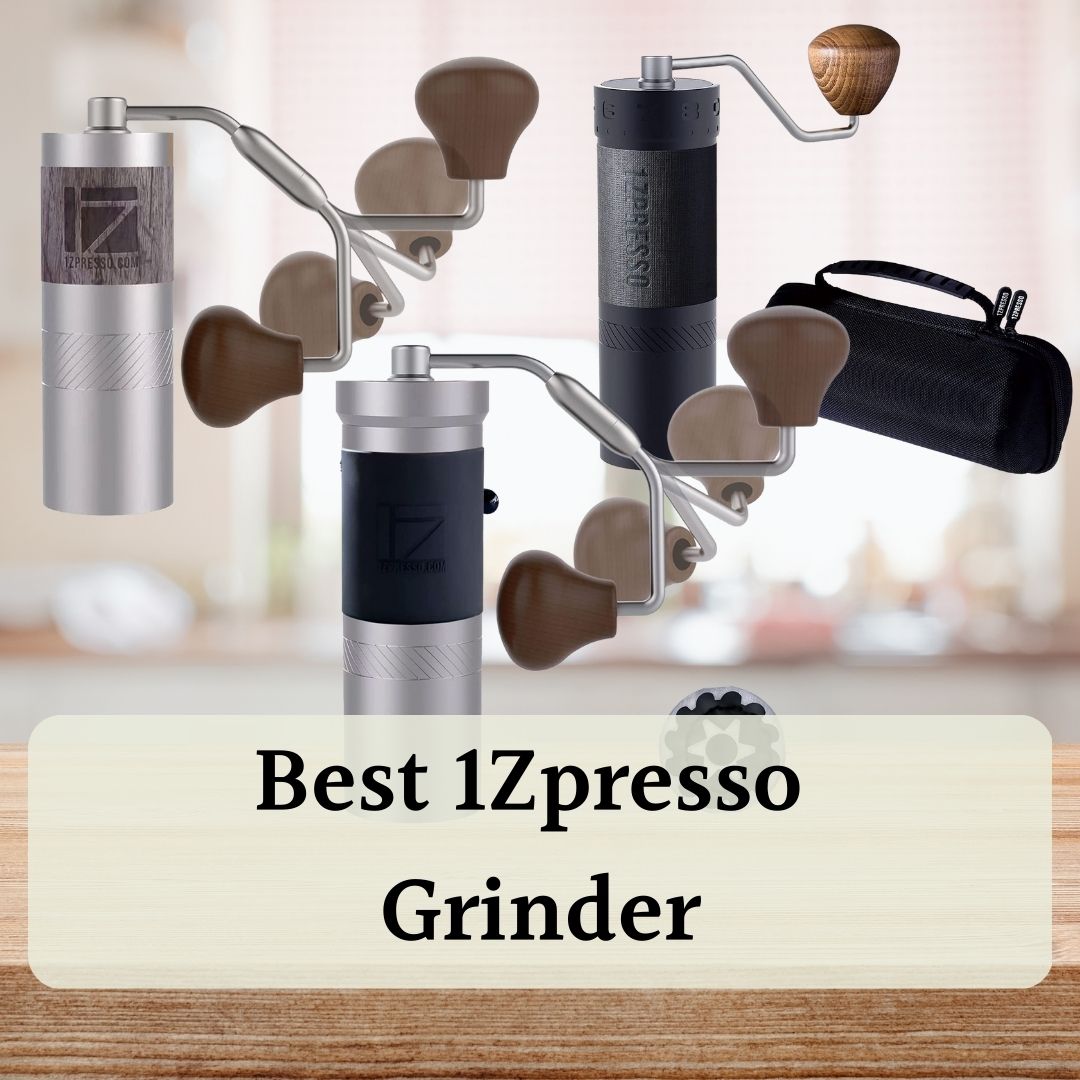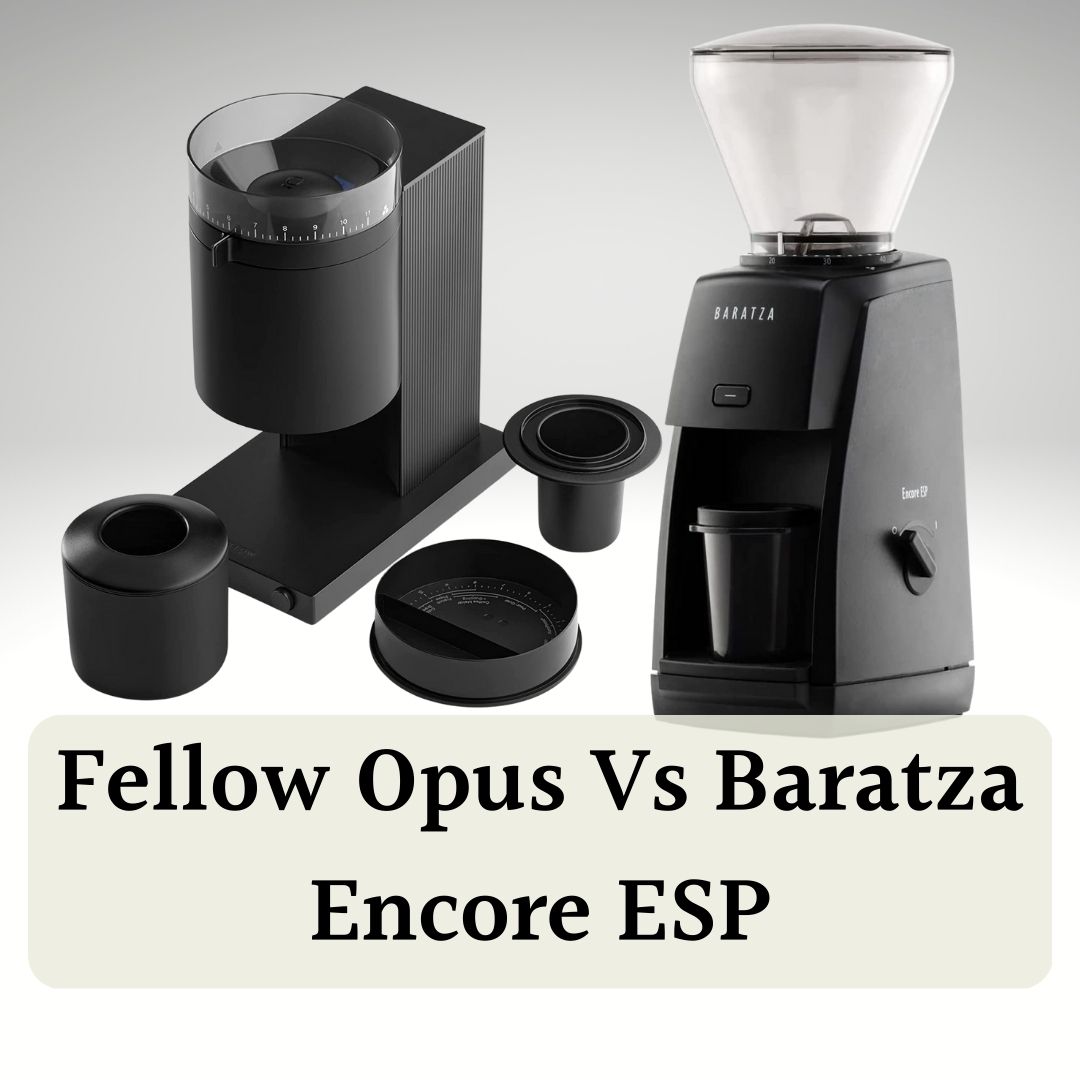If you’re researching burr grinders, you’ll find two distinct types of burrs: flat and conical. These are distinctly different, but the choice between a conical vs. flat burr grinder isn’t so straightforward.
There’s no right or wrong answer in the conical vs. flat burr debate. They are similar but different. Conical burr grinders are cheaper, quieter, and more forgiving. Flat burr grinders are more expensive and provide better control, which is why they are more commonly used in commercial settings.
I’ll lay out everything there’s to know about conical and flat burr grinders and explain where they excel, fall short, and why, so you can decide on the best burr grinder for you.
What are Conical and Flat Burr Grinders?
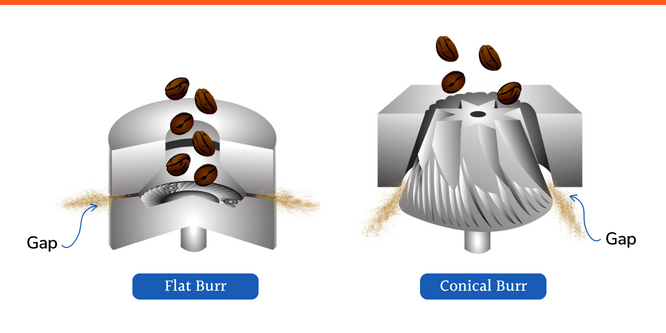
First, remember a burr grinder grinds coffee by using pressure as the beans go through two burr surfaces. The burrs are the essential components that pulverize whole coffee beans into powder.
Flat burr grinders have two rings located flat on each other (the burrs are donut-shaped). These are horizontally aligned and have small angled teeth that grind the beans into particles. Whole beans are fed into the middle whole, where they are grabbed by the inner teeth and made to go through the outside of the burrs, where the teeth are more frequent and precise.
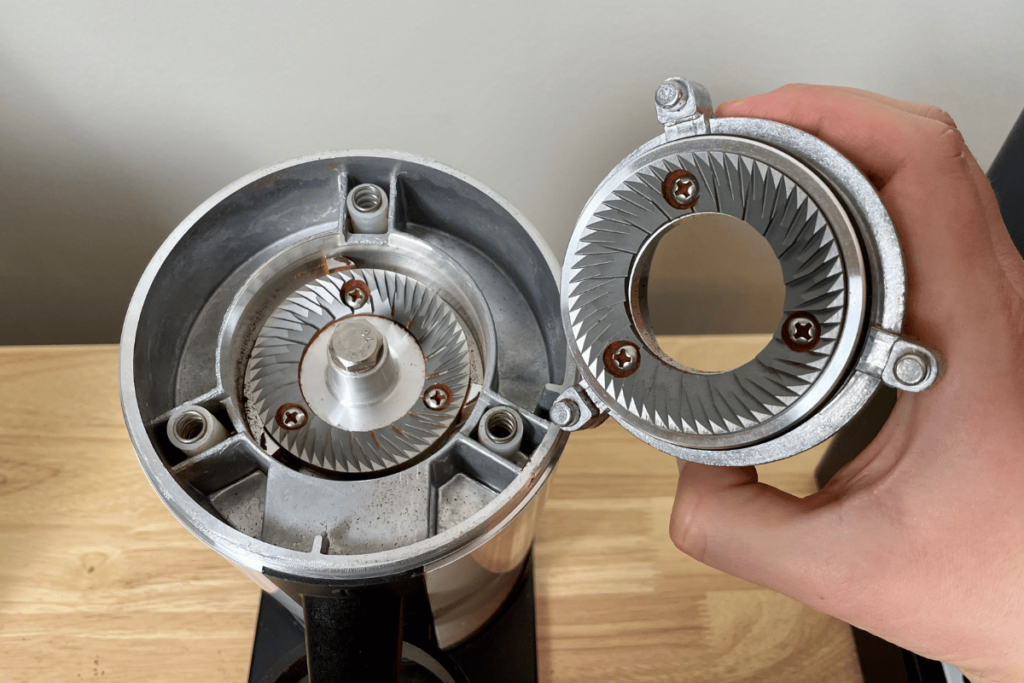
Overall, beans spend more time within flat burrs compared to conical, and that extra time means there’s more friction, which means more heat. A flat burr grinder also needs a stronger motor to spin the burrs, which produces more noise. Most importantly, flat burrs can create unimodal coffee grounds — if you check the grounds under a microscope, you won’t find two sets of ground sizes but only one.
Conical burr grinders have one burr inside another. The outer burr is circular and stationary*. It has a hollow ring and angled teeth. The inside burr is cone-shaped, has a larger base, and spins. As the inside burr spins, the sharp edges pull whole beans into the grinding area, where they are broken down into smaller pieces.
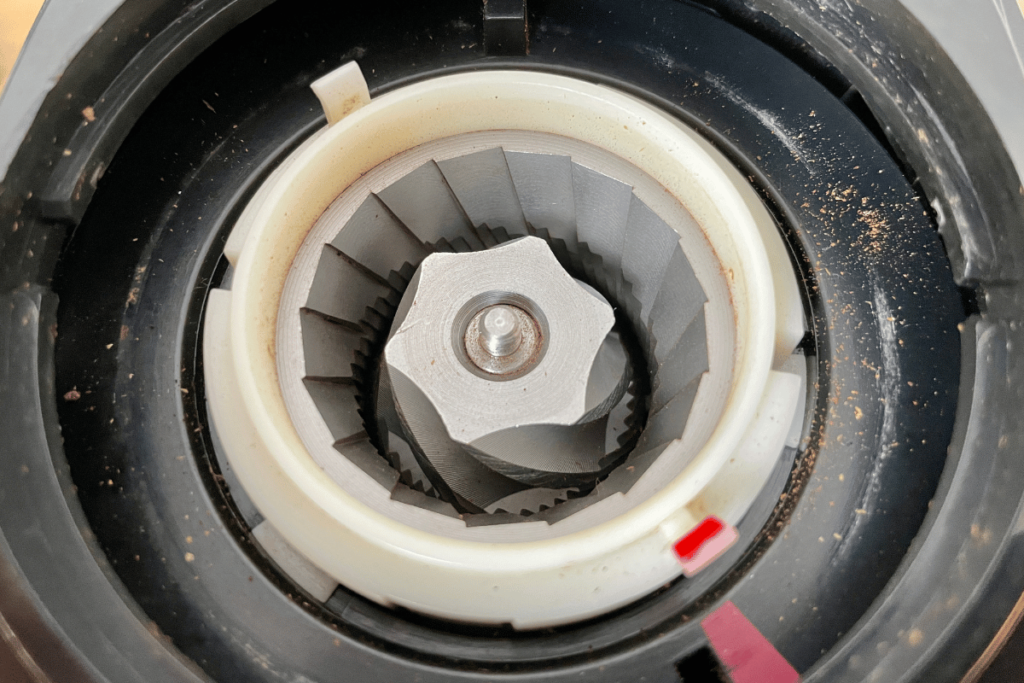
*There are some exceptions where the outer burr spins, such as the Baratza Sette grinder.
Conical burr coffee grinders have a fairly uniform grinding and a high level of grind size control. This is an efficient shape that doesn’t require a high-speed motor because gravity does much of the work pulling the beans through both burrs, so there’s less noise and heat. However, a conical burr grinder produces a bimodal distribution of coffee grounds. If you checked the ground coffee under the microscope, you’d notice two sets of coffee particles: one smaller and one larger.
Comparison of Conical and Flat Burr Grinders
Grind Consistency
A uniform size of coffee grounds results in an even extraction because all particles extract at the same rate. But, there are some differences in grind consistency between conical and flat burr shapes.
In a conical burr grinder, the coffee bean passes through increasing levels of friction as the rotating burr crushes it. The beans are pulled into an increasingly narrow space because the burr acts like an auger.
All coffee beans pass through this slim gap between the inner and the outer burr. In theory, each coffee particle should be the same or have a similar diameter. In reality, there are differences. You may get some tiny particles called fines.
Essentially, a conical burr grinder creates bimodal grind sizes. If you were to check the grinds under a microscope or use a sifter, you’d notice two sizes: fines (those super small grinds) and larger particles. In other words, bimodal. When you extract the coffee grounds, fines extract much faster than larger particles because of their small size. Fines can over-extract your coffee and create a bitter drink. They may also clog up filters and screens when making pour-over coffee.
The flat burr grinder spins at a higher speed. Its teeth and the continuous spinning push the coffee chips toward the grinding chamber’s exit. This results in coffee grinds having the same size, which is called the unimodal grind. It also means you’ll have a more even extraction because the grinds extract at the same rate.
However, one thing can make flat burrs inconsistent: heat. Flat burr coffee grinders generate more heat than conical burrs because they use more mechanical power. If flat burrs heat too much, they change the grind consistency.
The heat produced by the friction of the motor can negatively affect the coffee beans and alter the flavor. This is a bigger issue in commercial settings as the cafe heats and the ambient temperature increases. It’s rarely an issue at home because there’s time for the flat burrs to cool between grinding doses.
Noise
Noise is determined by the material used for the grinder’s body, the Revolutions Per Minute (RPM), and burr geometry.
Flat burrs need a higher RPM to make sure all the beans are forced into the grinding chamber and out the sides. They need a more powerful motor running at a high rate (for example, 700 RPM), which makes them very noisy.
On the other hand, conical burr coffee grinders run at a lower RPM than flat burrs. They don’t require high RPM, so they don’t need as powerful a motor. A less powerful motor means less noise.
Overall, conical burrs are quieter than flat burrs, which are known for their high-pitched whine.
However, this isn’t always the case, as the grinder’s outer material makes a big difference in muffling the motor’s noise (or not). For example, Turin’s flat burr grinders are far quieter than a conical Baratza Sette.
Grind Retention
Grind retention refers to the amount of coffee left behind in the grinding chamber, chute, and other parts of the coffee grinder. This can lead to issues such as stale grinds, lost money, and changing grind sizes. Mostly, it means you can get old coffee into your portafilter every time you grind. However, grind retention isn’t only determined by the shape of the burrs. It also depends on the burr angle, chamber, and chute.
That being said, conical burrs have lower retention because of their vertical placement in the grinder and gravity. The coffee grinds are pushed from the bottom of the burrs, not from the sides, so there are fewer grinds stuck in the teeth in the chamber.
Flat burrs have a higher retention rate because they are mounted horizontally and don’t have any help from gravity to expel the grinds. The grinds are pushed from the sides with the help of the motor, which leads to more grinds being left behind on the burr teeth.
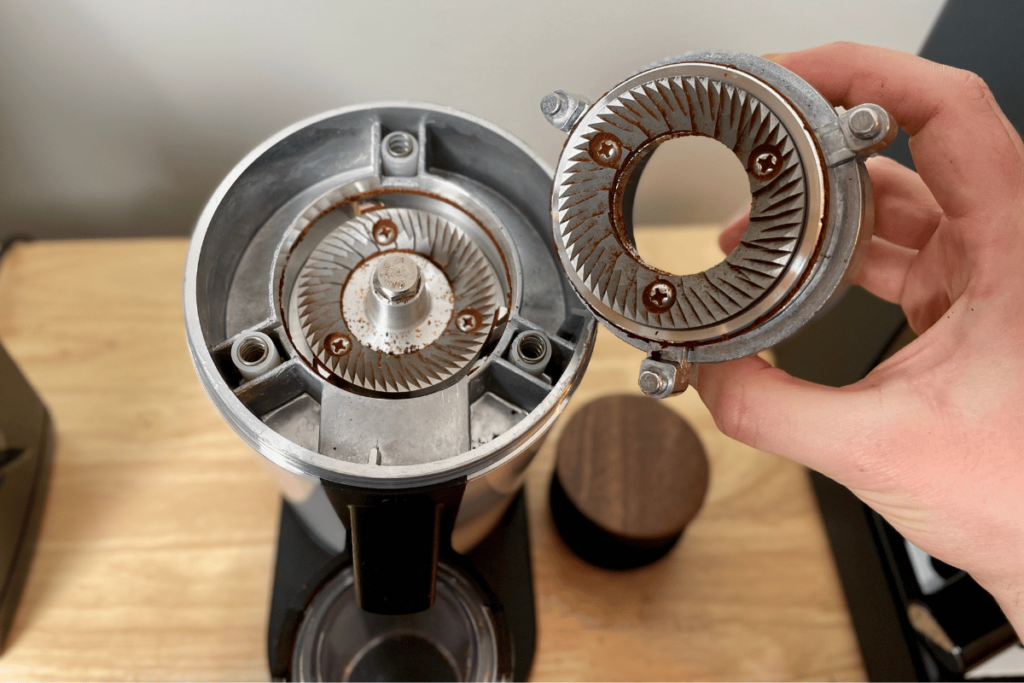
Note: Saying conical grinders have low retention and flat grinders have high retention is a generalization. Check the overall design of the grinder. For example, Iberital MC2 has a high retention, but Niche Zero has a low retention, and both of these are conical grinders.
Cost
A conical burr grinder is cheaper than flat burrs. You can find a conical burr for under $50, with high-end versions priced at several hundred dollars.
Flat burrs tend to be more expensive because of the more powerful motor. Their price goes from a few hundred dollars to over a thousand.
Which Should You Buy: A Flat or Conical Burr Grinder?
Flat burrs have a reputation for being more consistent and more expensive. They are also very noisy, and unless they come with good ventilation, they heat up quickly. The conical burr coffee grinder is cheaper, quieter, and cooler but less consistent.
Think about why you need a coffee grinder when deciding on the best one for you. Do you have a specialty coffee shop where precision is crucial? Or do you want a basic home grinder that won’t wake up your entire household in the mornings?
Also, think about which drinks you prefer. For example, you need fine grinds for espresso and Turkish-style coffee. But you need a medium setting for French Press and drip coffee. Generally, most burr grinders can create a good medium grind, but a fine one is more challenging because it requires calibration and burr precision.
To sum up, here are the pros and cons of conical and flat burrs to help you decide.
Conical burr: PROS
Low cost
Low heat
Low noise
No need to calibrate
Conical burr: CONS
Create bimodal grounds
Flat burr: PROS
Create unimodal grounds
Better espresso control
Flat burr: CONS
Expensive
Noisy
Tend to heat, especially in commercial settings
Conical vs. Flat Burrs: Final Thoughts
Each grinder is different, so it’s extremely difficult to make an apples-to-apples comparison. It’s not a matter of being right or wrong. There are excellent grinders on both sides, so think about your gear, technique, and preferred brewing method. If you just want a good cup of black coffee, you’ll be fine with a conical grinder. But if you’re an espresso fiend, you should consider investing in flat burrs.
Now that you know more about grinders than 99% of the population (congratulations, by the way), you need a great coffee machine to match your grinder. Check out our round-up of the best manual coffee machines. These produce delicious coffee and require a standalone grinder.


